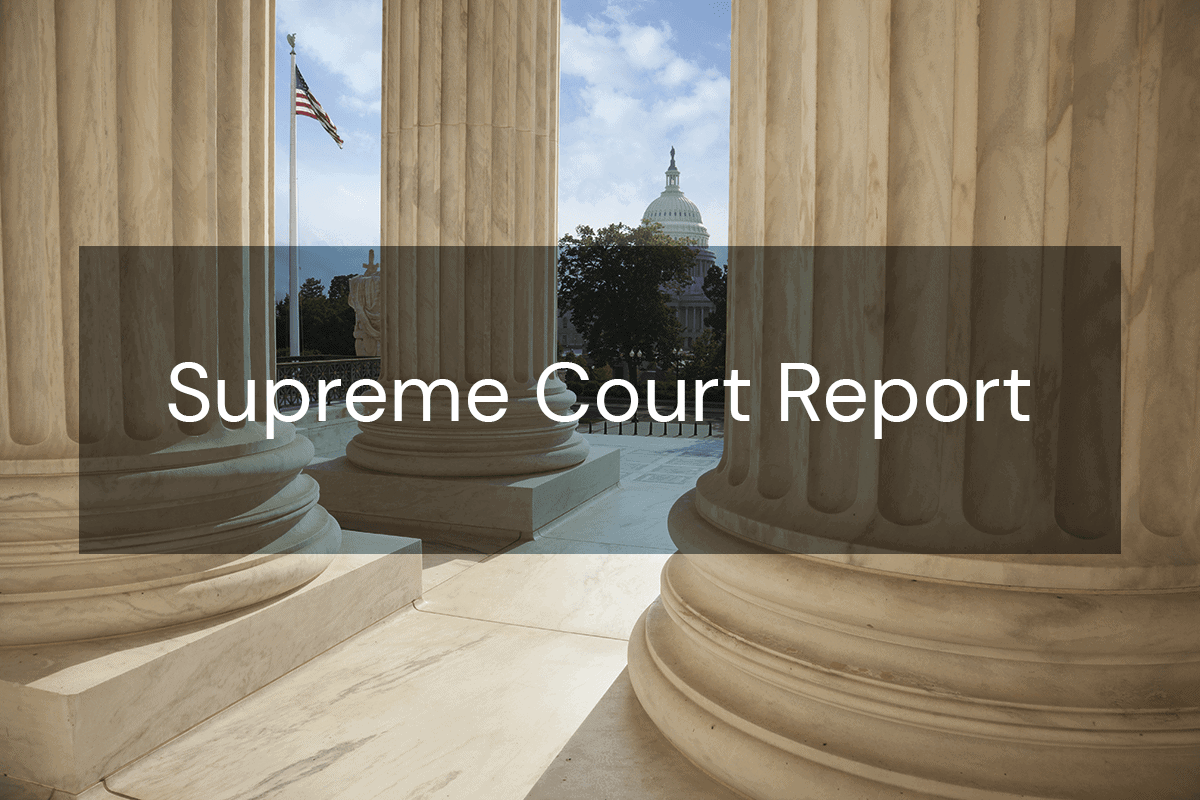-
 Director, Center for Supreme Court AdvocacyNational Association of Attorneys General
Director, Center for Supreme Court AdvocacyNational Association of Attorneys General

This Report summarizes opinions issued on April 21, 2022 (Part I).
Opinion: Brown v. Davenport, 20-826
Brown v. Davenport, 20-826. In a 6-3 opinion, the Court held that when a state court has ruled that a trial error was harmless, a federal habeas court must review that decision not only under Brecht v. Abrahamson, 507 U.S. 619 (1993), but also under AEDPA. Ervine Davenport was convicted of murder after a jury trial where he was shackled. The Michigan Supreme Court found that shackling violated Davenport’s right to due process because the trial judge did not articulate any special security need. The court remanded the case for the trial judge to determine whether the jury saw the shackles despite the use of a privacy screen around the defense table, and whether the prosecution could demonstrate that the shackling did not contribute to the verdict. Five jurors testified at an evidentiary hearing that they saw the restraints; the other seven did not. All 12 jurors testified that the shackles did not enter into their deliberations or influence the verdict. Based on this evidence and the strength of the evidence against Davenport, the trial court found the error harmless beyond a reasonable doubt, and Michigan’s appellate courts affirmed. Davenport filed a federal habeas petition, and the district court denied relief. A divided panel of the Sixth Circuit reversed, applying Brecht but not AEDPA. In an opinion written by Justice Gorsuch, the Court reversed the Sixth Circuit.
The Court began with a review of the history of the Great Writ, noting that at the founding, “a prisoner could not use it to challenge a final judgment of conviction issued by a court of competent jurisdiction.” “This traditional understanding,” found the Court, “extended from England to this country and persisted through much of our history.” The Court acknowledged that “the line between mere errors and jurisdictional defects was not always a ‘luminous beacon’ and it evolved over time, . . . [b]ut this Court generally sought to police the doctrine’s boundaries in cases involving federal and state prisoners alike.” (Citations omitted.) This all changed when “in Brown v. Allen this Court held that a state-court judgment ‘is not res judicata’ in federal habeas proceedings with respect to a petitioner’s federal constitutional claims. 344 U.S. 443, 458 (1953).” The Court explained that, “[e]ventually, this Court responded to the post-Brown habeas boom by devising new rules aimed at separating the meritorious needles from the growing haystack.” “Brecht was part of this effort.” In Brecht, the Court found that the harmlessness standard that applies on direct appeal, as articulated in Chapman v. California, 386 U.S. 18 (1967), does not adequately protect states’ interests in the finality of criminal judgments in the habeas context. The Court held that a habeas petitioner must show that a constitutional error had a “substantial and injurious effect or influence” on the verdict, stressing that habeas is an extraordinary remedy reserved for “extreme malfunctions in the state criminal justice system.” Three years after Brecht, Congress enacted AEDPA, which provides that federal courts “shall not” grant relief “unless” AEDPA’s terms are satisfied. Even then relief is not automatic; Congress “left intact the equitable discretion traditionally invested in federal courts by preexisting habeas statutes,” and a petitioner “must still today persuade a federal habeas court that law and justice require relief.” Thus, held the Court, a petitioner must meet AEDPA’s standard in addition to Court precedent such as Brecht. “Today, then, a federal court must deny relief to a state habeas petitioner who fails to satisfy either this Court’s equitable precedents or AEDPA. But to grant relief, a court must find that the petitioner has cleared both tests.”
Davenport advanced two arguments. First, he argued that the AEDPA inquiry is a logical subset of the Brecht test, and that by applying Brecht the Sixth Circuit implicitly found AEDPA satisfied. The Court disagreed, finding that the inquiries under AEDPA and Brecht are “entirely different in kind.” For example, “where AEDPA asks whether every fairminded jurist would agree that an error was prejudicial, Brecht asks only whether a federal habeas court itself harbors grave doubt about the petitioner’s verdict.” Also, “a petitioner might be able to prevail under Brecht thanks to favorable circuit case law but still lose under AEDPA because no comparable holding exists in this Court’s precedents.” Davenport’s case illustrates this distinction, because the Sixth Circuit did not claim that every reasonable jurist would share its doubts regarding prejudice, and it compared Davenport’s case to a “roughly analogous” case from the Ninth Circuit rather than clearly established Supreme Court precedent.
Second, Davenport argued that he should win under Fry v. Pliler, 551 U.S. 112 (2007), and Davis v. Ayala, 576 U.S. 257 (2015), which stated that Brecht “subsumes” the AEDPA standard. Although both cases contained language stating that Brecht “subsumes” AEDPA, the Court noted that the question was not presented in either case. AEDPA deference did not apply in Fry because no state court had ruled on the merits of the claim at issue. And in Ayala, the Court found that the Ninth Circuit misapplied Brecht, while also indicating that the petitioner could not meet AEDPA’s standard either. Thus, despite stating that Brecht “subsumed” AEDPA, neither case resolved whether a petitioner who has met the Brecht standard has automatically met AEDPA’s standard as well. The Court cautioned litigants not to parse the language of judicial opinions as though dealing with the language of a statute. The Court declined to override AEDPA’s standard “on the basis of a handful of sentences extracted from decisions that had no reason to pass on the argument.”
Assuming Davenport satisfied Brecht, as the Sixth Circuit found, the Court considered whether he could satisfy AEDPA as well. And so the Court asked whether the Michigan Court of Appeals’ ruling finding harmless error under Chapman was contrary to or an unreasonable application of clearly established Supreme Court law. (In asking that question, the Court noted that although the Michigan Supreme Court denied Davenport’s request for discretionary review, “a discretionary denial of leave to appeal does not typically entail an ‘adjudication’ of the underlying claim’s ‘merits’ under AEDPA’s terms.”) Davenport primarily argued that the Michigan Court of Appeals’ decision was contrary to or an unreasonable application of Holbrook v. Flynn, 475 U.S. 560 (1986). But Holbrook considered whether an error occurred at all when four uniformed state troopers sat in the first row of the courtroom, not whether any error was prejudicial. The jurors in Holbrook were questioned at the outset whether the troopers’ presence would affect their ability to fairly consider the case. In Davenport’s case, on the other hand, the Michigan court identified the controlling standard for prejudicial error and found that the shackling was harmless beyond a reasonable doubt based on the overwhelming evidence of guilt and the jurors’ testimony that they did not consider the shackles. Thus, AEDPA was not satisfied: “Even if some fairminded jurist applying Chapman could reach a different conclusion, we cannot say that every fairminded jurist must.”
Justice Kagan dissented, joined by Justices Breyer and Sotomayor. Justice Kagan first rejected the majority’s “law-chambers history,” disagreeing with its suggestion that habeas relief was “all but unavailable until the mid-20th century.” Rather, she argued, “[f]ederal courts long before Brown extended habeas relief to prisoners held in violation of the Constitution―even after a final conviction.” “Contrary to the majority, then, our decision in Brown built on decades and decades of history.” But, Justice Kagan wrote, this historical dispute “has precious little—no, has nothing—to do with resolving this case.” As to the dispute here, the dissent maintained that Fry and Ayala correctly explained that the Brecht standard “subsumes” AEDPA’s standard; if a defendant meets the former, he “necessarily” meets the latter as well. According to Justice Kagan, “if the habeas court confines itself to using AEDPA-approved materials, then it need only find the Brecht standard met to grant relief.” She predicted that no habeas court with a “grave doubt” that an error affected the verdict will say that a reasonable jurist could deny a reasonable possibility that the error mattered. The dissent found no cases in which a court found that a petitioner satisfied Brecht but not AEDPA, and surmised that the majority’s AEDPA analysis revealed that it simply had no “grave doubt” under Brecht.



